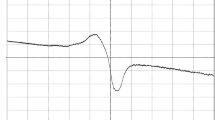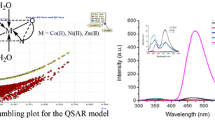Abstract
Three new Schiff base compounds were synthesized via condensation of 3-R-4-amino-5-hydrazino-1,2,4-triazole with dibenzoylmethane [R = H, CH3, and CH2CH3 namely L1, L2, and L3, respectively]. The synthesized Schiff bases were characterized using melting point, CHN elemental analyses, FT-IR, and 1H-NMR. The corresponding Cu(II) Schiff base complexes were synthesized via refluxing the prepared Schiff bases with CuCl2·2H2O. The synthesized complexes have been characterized by means of different spectral tools (FT-IR, ESR, and UV–Vis spectra) in addition to elemental analysis, magnetic moment, conductivity, and thermal analysis. The synthesized copper complexes are nonelectrolytes in N,N-dimethylformamide (DMF) based on their conductance values. Using modified Bauer-Kirby method, the Schiff bases and their Cu(II) complexes have been tested for antifungal (Candida albicans and Aspergillus flavus) and antibacterial (Staphylococcus aureus and Escherichia coli) activities. Moreover, CuO nanoparticles were produced via thermal decomposition of the synthesized Cu(II) complexes at 650 °C. The produced nanoparticles were characterized using XRD, HR-TEM, FT-IR, and UV–Vis spectroscopy. The CuO nanostructures exhibited good photocatalytic activity for the degradation of methylene blue dye in the presence of hydrogen peroxide with 77.36% degradation efficiency in 360 min.
Graphical Abstract
Proposed structure of the synthesized Cu(II) complexes









Similar content being viewed by others

References
R. Shukla, T.P. Mohan, B. Vishalakshi, D. Chopra, Synthesis, crystal structure and theoretical analysis of intermolecular interactions in two biologically active derivatives of 1,2,4-triazoles. J. Mol. Struct. 1134 426–434 (2017)
A.E.-B.A.G. Ghattas, H.M. Moustafa, E.A.A. Hassanein, B.R.M. Hussein, Synthesis and antibacterial activity of some new 4-anilino-5-phenyl-4H-1,2,4-triazole-3-thiol derivatives. Arab. J. Chem. 9, S1654–S1659 (2016)
Z. Song, Y. Liu, Z. Dai, W. Liu, K. Zhao, T. Zhang, Y. Hu, X. Zhang, Y. Dai, Synthesis and aromatase inhibitory evaluation of 4-N-nitrophenyl substituted amino-4H-1,2,4-triazole derivatives. Bioorg. Med. Chem. 24, 4723–4730 (2016)
N. Kulabas, E. Tatar, O. Bingol Ozakpinar, D. Ozsavci, C. Pannecouque, E. De Clercq, I. Kucukguzel, Synthesis and antiproliferative evaluation of novel 2-(4H-1,2,4-triazole-3-ylthio)acetamide derivatives as inducers of apoptosis in cancer cells. Eur. J. Med. Chem. 121, 58–70 (2016)
K. Wajda-Hermanowicz, D. Pieniążczak, R. Wróbel, A. Zatajska, Z. Ciunik, S. Berski, A study on the condensation reaction of aryl substituted 4-amine-1,2,4-triazole with benzaldehydes: structures and spectroscopic properties of schiff bases and stable hemiaminals. J. Mol. Struct. 1114, 108–122 (2016)
R. Alphonse, A. Varghese, L. George, Synthesis, characterization and photophysical studies of a novel schiff base bearing 1, 2, 4-Triazole scaffold. J. Mol. Struct. 1113, 60–69 (2016)
B.N. Prasanna Kumar, K.N. Mohana, L. Mallesha, Synthesis and antiproliferative activity of some new fluorinated Schiff bases derived from 1,2,4-triazoles. J. Fluorine. Chem. 156, 15–20 (2013)
H. Khanmohammadi, M. Erfantalab, G. Azimi, New acyclic 1,2,4-triazole-based Schiff base hydrazone: synthesis, characterization, spectrophotometric and computational studies. Spectrochim. Acta. A 105, 338–343 (2013)
H.M. Aly, M.E. Moustafa, M.Y. Nassar, E.A. Abdelrahman, Synthesis and characterization of novel Cu(II) complexes with 3-substituted-4-amino-5-mercapto-1,2,4-triazole Schiff bases: a new route to CuO nanoparticles. J. Mol. Struct. 1086, 223–231 (2015)
M. Iranifam, N.R. Hendekhale, CuO nanoparticles-catalyzed hydrogen peroxide–sodium hydrogen carbonate chemiluminescence system used for quenchometric determination of atorvastatin, rivastigmine and topiramate. Sens. Actuators. B. Chem. 243, 532–541 (2017)
M. Maruthupandy, Y. Zuo, J.-S. Chen, J.-M. Song, H.-L. Niu, C.-J. Mao, S.-Y. Zhang, Y.-H. Shen, Synthesis of metal oxide nanoparticles (CuO and ZnO NPs) via biological template and their optical sensor applications. Appl. Sur. Sci. 397, 167–174 (2017)
P. Liu, X. Xia, W. Lei, Q. Hao, Rational synthesis of highly uniform hollow core–shell Mn3O4/CuO@TiO2 submicroboxes for enhanced lithium storage performance. Chem. Eng. J. 316, 214–224 (2017)
A. Ajmal, I. Majeed, R.N. Malik, M. Iqbal, M.A. Nadeem, I. Hussain, S. Yousaf, G. Zeshan, Mustafa, M.I. Zafar, M.A. Nadeem, Photocatalytic degradation of textile dyes on Cu2O-CuO/TiO2 anatase powders. J. Environ. Chem. Eng. 4, 2138–2146 (2016)
A. Taufik, R. Saleh, Synthesis of iron(II, III) oxide/zinc oxide/copper(II) oxide (Fe3O4/ZnO/CuO) nanocomposites and their photosonocatalytic property for organic dye removal. J. Colloid. Interface. Sci. 491, 27–36 (2017)
H. Xie, L. Zhu, W. Zheng, J. Zhang, F. Gao, Y. Wang, Microwave-assisted template-free synthesis of butterfly-like CuO through Cu2Cl(OH)3 precursor and the electrochemical sensing property. Solid. State. Sci. 61, 146–154 (2016)
S. Sonia, R. Jayasudha, N.D. Jayram, P.S. Kumar, D. Mangalaraj, S.R. Prabagaran, Synthesis of hierarchical CuO nanostructures: biocompatible antibacterial agents for Gram-positive and Gram-negative bacteria. Curr. Appl. Phys. 16, 914–921 (2016)
C. Dong, X. Xing, N. Chen, X. Liu, Y. Wang, Biomorphic synthesis of hollow CuO fibers for low-ppm-level n-propanol detection via a facile solution combustion method. Sens. Actuators. B. Chem. 230, 1–8 (2016)
X. Liu, G. Liu, L. Wang, Y. Li, Y. Ma, J. Ma, Morphology- and facet-controlled synthesis of CuO micro/nanomaterials and analysis of their lithium ion storage properties. J. Power. Sources 312, 199–206 (2016)
G.B. Bagihalli, S.A. Patil, Synthesis, spectral characterization, in vitrobiological and DNA cleavage studies of Co(II), Ni(II), Cu(II), and Zn(II) complexes with 1,2,4-triazole Schiff bases. J. Coord. Chem. 62, 1690–1700 (2009)
B. Shivarama Holla, B. Veerendra, M.K. Shivananda, B. Poojary, Synthesis characterization and anticancer activity studies on some Mannich bases derived from 1,2,4-triazoles. Eur. J. Med. Chem. 38, 759–767 (2003)
M.Y. Nassar, E.I. Ali, E.S. Zakaria, Tunable auto-combustion preparation of TiO2 nanostructures as efficient adsorbents for the removal of an anionic textile dye. RSC Adv. 7(13), 8034–8050 (2017)
M.Y. Nassar, T.Y. Mohamed, I.S. Ahmed, I. Samir, MgO nanostructure via a sol-gel combustion synthesis method using different fuels: an efficient nano-adsorbent for the removal of some anionic textile dyes. J. Mol. Liq. 225, 730–740 (2017)
M.Y. Nassar, M.M. Moustafa, M.M. Taha, Hydrothermal tuning of the morphology and particle size of hydrozincite nanoparticles using different counterions to produce nanosized ZnO as an efficient adsorbent for textile dye removal. RSC Adv. 6(48), 42180–42195 (2016)
M.Y. Nassar, S. Abdallah, Facile controllable hydrothermal route for porous CoMn2O4 nanostructure: synthesis, characterization, and textile dye removal from aqueous media. RSC Adv. 6(87), 84050–84067 (2016)
M.Y. Nassar, M. Khatab, Cobalt ferrite nanoparticles via a template-free hydrothermal route as an efficient nano-adsorbent for potential textile dye removal. RSC Adv. 6(83), 79688–79705 (2016)
M.Y. Nassar, I.S. Ahmed, I. Samir, A novel synthetic route for magnesium aluminate (MgAl2O4) nanoparticles using sol–gel auto combustion method and their photocatalytic properties. Spectrochim. Acta Part A 131, 329–334 (2014)
M. Mostafa, H.M. Saber, A.A. El-Sadek, M.Y. Nassar, Preparation and performance of 99Mo/99mTc chromatographic column generator based on zirconium molybdosilicate. Radiochim. Acta 104, 257–265 (2016)
A.K. Singh, O.P. Pandey, S.K. Sengupta, Synthesis, spectral characterization and biological activity of zinc(II) complexes with 3-substituted phenyl-4-amino-5-hydrazino-1, 2, 4-triazole Schiff bases. Spectrochim. Acta. Part A 85, 1–6 (2012)
G.B. Bagihalli, P.G. Avaji, S.A. Patil, P.S. Badami, Synthesis, spectral characterization, in vitro antibacterial, antifungal and cytotoxic activities of Co(II), Ni(II) and Cu(II) complexes with 1,2,4-triazole Schiff bases. Eur. J. Med. Chem. 43, 2639–2649 (2008)
M.Y. Nassar, A.S. Attia, K.A. Alfallous, M.F. El-Shahat, Synthesis of two novel dinuclearmolybdenum(0) complexes of quinoxaline-2,3-dione: new precursors for preparation of α-MoO3 nanoplates. Inorg. Chim. Acta 405, 362–367 (2013)
M.Y. Nassar, I.S. Ahmed, Hydrothermal synthesis of cobalt carbonates using different counter ions: an efficient precursor to nano-sized cobalt oxide (Co3O4). Polyhedron 30, 2431–2437 (2011)
M.Y. Nassar, I.S. Ahmed, Template-free hydrothermal derived cobalt oxide nanopowders: synthesis, characterization, and removal of organic dyes. Mater. Res. Bull. 47, 2638–2645 (2012)
M.Y. Nassar, Size-controlled synthesis of CoCO3 and Co3O4 nanoparticles by free-surfactant hydrothermal method. Mater. Lett. 94, 112–115 (2013)
M.Y. Nassar, T.Y. Mohamed, I.S. Ahmed, One-pot solvothermal synthesis of novel cobalt salicylaldimine–urea complexes: a new approach to Co3O4 nanoparticles. J. Mol. Struct. 1050, 81–87 (2013)
M.Y. Nassar, A.S. Amin, I.S. Ahmed, S. Abdallah, Sphere-like Mn2O3 nanoparticles: facile hydrothermal synthesis and adsorption properties., J. Taiwan Inst. Chem. Eng. 64 79–88 (2016)
M.Y. Nassar, I.S. Ahmed, T.Y. Mohamed, M. Khatab, A controlled, template-free, and hydrothermal synthesis route to sphere-like α-Fe2O3 nanostructures for textile dye removal. Rsc. Adv. 6, 20001–20013 (2016)
Author information
Authors and Affiliations
Corresponding author
Rights and permissions
About this article
Cite this article
Nassar, M.Y., Aly, H.M., Moustafa, M.E. et al. Synthesis, Characterization and Biological Activity of New 3-substitued-4-amino-5-hydrazino-1,2,4-triazole Schiff Bases and Their Cu(II) Complexes: A New Approach to CuO Nanoparticles for Photocatalytic Degradation of Methylene Blue Dye. J Inorg Organomet Polym 27, 1220–1233 (2017). https://doi.org/10.1007/s10904-017-0569-x
Received:
Accepted:
Published:
Issue Date:
DOI: https://doi.org/10.1007/s10904-017-0569-x



